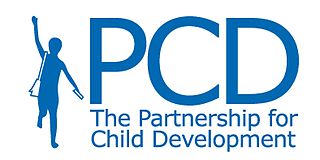
Head Start is a program of the United States Department of Health and Human Services that provides comprehensive early childhood education, health, nutrition, and parent involvement services to low-income children and families. The program's services and resources are designed to foster stable family relationships, enhance children's physical and emotional well-being, and establish an environment to develop strong cognitive skills. The transition from preschool to elementary school imposes diverse developmental challenges that include requiring the children to engage successfully with their peers outside the family network, adjust to the space of a classroom, and meet the expectations the school setting provides.

A preschool, also known as nursery school, pre-primary school, play school or creche, is an educational establishment or learning space offering early childhood education to children before they begin compulsory education at primary school. It may be publicly or privately operated, and may be subsidized from public funds.

Early childhood education (ECE), also known as nursery education, is a branch of education theory that relates to the teaching of children from birth up to the age of eight. Traditionally, this is up to the equivalent of third grade. ECE is described as an important period in child development.
The Early Childhood Education Act is the name of various landmark laws passed by the United States Congress outlining federal programs and funding for childhood education from pre-school through kindergarten. The first such act was introduced in the United States House of Representatives by Congresswoman Patsy Mink of Hawaiʻi in the 1960s. The theory behind the act is that the years before a child reaches kindergarten are the most critical to influence learning. Many children do not have access to early education before entering kindergarten. The goal of the act is to provide a comprehensive set of services for children from birth until they enter kindergarten.
A form of child abuse, child neglect is an act of caregivers that results in depriving a child of their basic needs, such as the failure to provide adequate supervision, health care, clothing, or housing, as well as other physical, emotional, social, educational, and safety needs. All societies have established that there are necessary behaviours a caregiver must provide for a child to develop physically, socially, and emotionally. Causes of neglect may result from several parenting problems including mental disorders, unplanned pregnancy, substance use disorder, unemployment, over employment, domestic violence, and, in special cases, poverty.
Early childhood intervention (ECI) is a support and educational system for very young children who have been victims of, or who are at high risk for child abuse and/or neglect as well as children who have developmental delays or disabilities. Some states and regions have chosen to focus these services on children with developmental disabilities or delays, but Early Childhood Intervention is not limited to children with these disabilities.

The Partnership for Child Development (PCD) is a research and technical assistance group based at Imperial College London that seeks to improve health and nutrition in school-age children and youth in low-income countries, thereby improving their education outcomes. PCD was formed in 1992 at the University of Oxford to bridge gaps between academia, funding bodies and the education and health sectors in low-income countries.
The Maternal and Child Health Bureau (MCHB), is one of six Bureaus within the Health Resources and Services Administration, an agency of the U.S. Department of Health and Human Services located in Rockville, Maryland.
Life skills are abilities for adaptive and positive behavior that enable humans to deal effectively with the demands and challenges of life. This concept is also termed as psychosocial competency. The subject varies greatly depending on social norms and community expectations but skills that function for well-being and aid individuals to develop into active and productive members of their communities are considered as life skills.

The Foundation for the Development of Caribbean Children (FDCC) is a nonprofit organisation helps disadvantaged young children in the Caribbean to reach their full potential through early childhood development (ECD) outreach. Headquartered in Bridgetown, Barbados and serving the entire Caribbean, the FDCC is the region's first indigenous foundation working in the ECD field. To improve the care environment for the region's youngest children, the FDCC prioritises access to good-quality ECD services and seeks to improve children's readiness to enter primary school. The FDCC creates, controls and manages projects in several Caribbean nations. It also distributes resources as required. By targeting socially disadvantaged young children, the FDCC is different from other organisations working in the Caribbean ECD sector. Typically, other organisations and governments support mainstream, older children.
Video interaction guidance (VIG) is a video feedback intervention through which a “guider” helps a client to enhance communication within relationships. The client is guided to analyse and reflect on video clips of their own interactions. Applications include a caregiver and infant, and other education and care home interactions. VIG is used in more than 15 countries and by at least 4000 practitioners. Video Interaction Guidance has been used where concerns have been expressed over possible parental neglect in cases where the focus child is aged 2–12, and where the child is not the subject of a child protection plan.
Curriculum development is a process of improving the curriculum. Various approaches have been used in developing curricula. Commonly used approaches consist of analysis, design, selectingformation and review.
- Analysis
- Design
- Selecting
- Formation
- Review

First 5 Los Angeles is a nonprofit child-advocacy organization that is part of the First 5 California Children and Families Act.
The History of early childhood care and education (ECCE) refers to the development of care and education of children between birth and eight years old throughout history. ECCE has a global scope, and caring for and educating young children has always been an integral part of human societies. Arrangements for fulfilling these societal roles have evolved over time and remain varied across cultures, often reflecting family and community structures as well as the social and economic roles of women and men. Historically, such arrangements have largely been informal, involving family, household and community members. The formalization of these arrangements emerged in the nineteenth century with the establishment of kindergartens for educational purposes and day nurseries for care in much of Europe and North America, Brazil, China, India, Jamaica and Mexico.

Children in emergencies and conflicts constitutes the effects of situations that pose detrimental risks to the health, safety, and well-being of children. There are many different kinds of conflicts and emergencies, for example, violence, armed conflicts, war, natural disasters, etc. Approximately 13 million children are displaced by armed conflicts and violence around the world. Where violent conflicts are the norm, the lives of young children are significantly disrupted and their families have great difficulty in offering the sensitive and consistent care that young children need for their healthy development. Studies on the effect of emergencies and conflict on the physical and mental health of children between birth and 8 years old show that where the disaster is natural, the rate of PTSD occurs in anywhere from 3 to 87 per cent of affected children. However, rates of PTSD for children living in chronic conflict conditions varies from 15 to 50 per cent as evidenced in the following countries: Iran, Iraq, Israel, Kuwait, Lebanon, Palestine, Rwanda, South Africa, and Sudan.
Child health and nutrition in Africa is concerned with the health care of children through adolescents in the various countries of Africa. The right to health and a nutritious and sufficient diet are internationally recognized fundamental human rights protected by international treaties and conventions on the right to life, as well as in charters, strategies and declarations. Millennium Development Goals (MDGs) 1, 4, 5 and 6 highlight, respectively, how poverty, hunger, child mortality, maternal health, the eradication of HIV/AIDS, malaria, tuberculosis and other diseases are of particular significance in the context of child health.
Child development in Africa addresses the variables and social changes that occur in African children from infancy through adolescence. Three complementary lines of scholarship have sought to generate knowledge about child development in Africa, specifically rooted in endogenous, African ways of knowing: analysis of traditional proverbs, theory-building, and documentation of parental ethno-theories. The first approach has examined the indigenous formulations of child development and socialisation values embedded in African languages and oral traditions. Several collections of proverbs have been published in different African languages, and their content has been analysed to show the recurrence of the themes of shared communal responsibility for children's moral guidance and the importance of providing it early in life.
Curricula in early childhood care and education (ECCE) or early childhood curriculum address the role and importance of curricula in the education of young children, and is the driving force behind any ECCE programme. It is ‘an integral part of the engine that, together with the energy and motivation of staff, provides the momentum that makes programmes live’. It follows therefore that the quality of a programme is greatly influenced by the quality of its curriculum. In early childhood, these may be programmes for children or parents, including health and nutrition interventions and prenatal programmes, as well as centre-based programmes for children.
Early childhood education in the United States relates to the teaching of children from birth up to the age of eight. The education services are delivered via preschools and kindergartens.
The Survey of Teachers in Pre-Primary Education (STEPP) is the first international survey for low-and-middle-income countries designed to collect information that is known to affect the quality of pre-primary education from pre-primary teachers and centre heads. The collected information concerns training and professional development, pedagogical and professional practices, working conditions and job satisfaction, and characteristics of pre-primary personnel and the settings in which they work.
![]() This article incorporates text from a free content work. Licensed under CC-BY-SA IGO 3.0( license statement/permission ). Text taken from Investing against Evidence: The Global State of Early Childhood Care and Education , 159-164, Marope, P.T.M., Kaga, Y., UNESCO. UNESCO.
This article incorporates text from a free content work. Licensed under CC-BY-SA IGO 3.0( license statement/permission ). Text taken from Investing against Evidence: The Global State of Early Childhood Care and Education , 159-164, Marope, P.T.M., Kaga, Y., UNESCO. UNESCO. 





